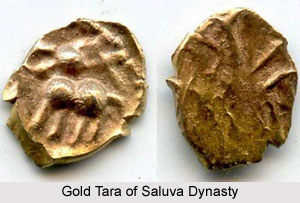 Saluva dynasty was one of the ruling dynasties of Vijayanagar Empire of southern India. Three rulers from 1485 till 1505 ruled over the dynasty subsequent to which the Tuluva dynasty asserted the throne. They reigned over the entire south India with Vijayanagara as their capital.
Saluva dynasty was one of the ruling dynasties of Vijayanagar Empire of southern India. Three rulers from 1485 till 1505 ruled over the dynasty subsequent to which the Tuluva dynasty asserted the throne. They reigned over the entire south India with Vijayanagara as their capital.
Saluva Narasimha Deva Raya
Saluva Narasimha Deva Raya (1485-1491 CE) was the king of the Vijayanagara Empire from the Saluva dynasty. As patron of the Madhwa saint Sripadaraya, he instigated the Sanskrit work Ramabhyudayam. In 1452, Saluva Narasimha Deva Raya was given the title `Mahamandaleshwara of Chandragiri` during the reign of Mallikarjuna Raya. His father Saluva Gunda was the administrator of Chandragiri. Subsequent to the demise of Virupaksha Raya II and onset of Prauda Deva Raya as the new-fangled emperor of Vijayanagara, the territory pitched into anarchy. Considering that a martial overthrow was the only hope to hoard the kingdom, he posted the son of Tuluva Isvara, Tuluva Narasa Nayaka, to the majestic capital of Vijayanagara. Afterwards the serving king, Prauda Raya, fled thus initiating the rule of Saluva Narasimha. The writings of Nuniz provide a graphic account of how Narasa Nayaka went to Vijayanagara and found it completely unguarded, even all the way to the harem.
As king, Saluva Narashima tried to develop the empire; he continually confronted difficulties caused from rebelling chieftains. By 1491, he lost Udayagiri to Gajapati Kapilendra while the chiefs of Ummattur in the Mysore region, Saluvas of Hadavalli and Santharas of Karkala from coastal Karnataka region, Srirangapatna and Sambetas of Peranipadu in Cuddapah still remained threats to the empire. Saluva Narashima`s war with the Gajapatis over Udayagiri in 1489 proved disastrous when he was taken to the prison and released later after giving up the fort and surrounding areas. However he was successful at conquering the western ports of Kannada country of Mangalore, Bhatkal, Honnavar and Bakanur. This success enabled him to trade for swift horses with the Arabs. He put more efforts in maintaining his cavalry and army.
Saluva Narashima ultimately passed away in 1491. However, at the time, his sons were too juvenile to soar to the throne. Hence the sons were left to the care of Narasa Nayaka, a trustworthy general and minister from the Tuluva family.
Thimma Bhupa
Thimma Bhupa was the son of Saluva Narasimha Deva Raya, the king of Vijayanagara Empire. Prince Thimma ascended his father in 1491 but was shortly murdered by an army commander during a stage of political turmoil in Vijayanagar. His younger brother Narasimha Raya II ascended him to the throne.
Narasimha Raya II
Narasimha Raya II was the second son of King Saluva Narasimha Deva Raya. He attained authority, subsequent to the assassination of his elder brother Thimma Bhupala. Although he was a pronounced king of Vijayanagar Empire, the authentic control was always in the hands of the empire`s competent commander Tuluva Narasa Nayaka. In 1505, Narasimha Raya II was slayed in Penukonda where Tuluva Narasa Nayaka had imprisoned him for his safety.



















